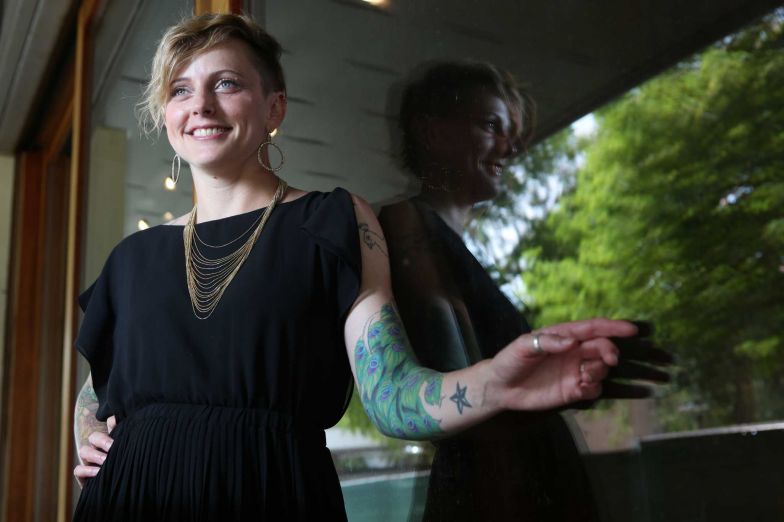By Amanda Scott

Lacy M. Johnson’s experience and interests span multitudes. She is a wife, mother, teacher, and, of course, writer. Fortunately for Story|Houston, we have the pleasure of not only hosting Lacy as the judge for our fiction and non-fiction contest, but also as the subject of our first-ever interview exclusive—a treat, indeed. In this brief spotlight, you’ll learn about Lacy’s background, writing aesthetic, what she’s been reading, and some reads she’s looking forward to. Enjoy.
What initially drew you to memoir and essays?
I initially started writing essays because they felt like the best container for what I wanted to say. My formal training is as a poet, but at a certain point in that training I realized that when I write poetry it feels like I’m reaching for an aesthetic that’s not authentic to me, like I’m wearing someone else’s broken-in shoes. When I switched to writing essays, I found the form to be nimble and flexible, and comfortably accommodating to my own peculiar inventions. I love poetry, and still read it voraciously. But eventually I realized that essays, especially the lyric essay, fit like the one shoe made just for me.
You have a way with style. At times it is measured and subtle, while at others, it favors a more poetic and fragmented form. How do you move between the two and how do you determine the appropriate voice or style for something?
To me it’s all the same voice, which is my voice, which spans many styles, or what I might call “registers.” I come from the rural Midwest, and grew up surrounded by plain-spoken people. This is my inherited vocabulary, which is agrarian, earthy, simple. After I moved away from there, I studied music, and literature, philosophy, and post-structural theory, and those vocabularies became part of my experience. Now I teach art and read in Spanish as well as English, so I have those vocabularies as well. Imagine all of these interests and experiences and inheritances as circles. My voice—the one voice that is mine, which is the accumulation of these many distinct styles and registers—is where all of those circles overlap. My writing voice—just like anyone’s writing voice—is the unique Venn diagram of the vocabularies of my particular experience.
What do you look for in a good piece of prose, be it fiction or non-fiction?
Here are some questions I’ve learned that I ask myself—mostly subconsciously—when I’m reading a new work: Does this writer know her (or his) way around a sentence? Does this writer have anything at stake in this work? Has this writer risked anything in writing this? If it becomes clear in the first few pages that the answer to any of these questions is no, then I stop reading. Life is short, after all.
One of your main creative interests seems to be memoir writing, but you are also deeply involved in other endeavors such as teaching, activism, and I’m sure others. How do you think these pursuits and passions inform your writing and vice versa?
I don’t think of my various practices as being particularly separate from one another. They might appear to take different forms, but really, when it comes right down to it, all of my work is connected by a certain set of questions. One of the questions I’m thinking a lot about lately is, “what is the role of the artist in society?” I explore this question in my writing, but I also explore it in my teaching. Last semester, for instance, I taught a class at the University of Houston called “Art as Activism,” in which my question about the role of the artist became a central one; my students and I considered this question from many angles—artistically, philosophically, logistically, legally—and we allowed the conclusions we drew to inform our creative and critical work, which in turned informed our activism, and will ideally continue to inform us as we go on to pursue other questions after this.
What’s on your summer reads docket this season?
I’m reading (and loving) Mat Johnson’s Loving Day right now. He’s such a marvelous storyteller, and the novel, which is about being biracial in America, is all at once hilarious, profound, and deeply insightful. I’ve just finished Maggie Nelson’s The Argonauts and I’m working through her Art of Cruelty right now. She’s probably my favorite writer alive today. I’ve also just finished Nick Flynn’s My Feelings, which is probably his best poetry collection since Some Ether. I’m looking forward to Lidia Yuknavitch’s The Small Backs of Children, and The Hundred-Year Flood by Matthew Salesses. On top of that, I have about a zillion books in the pile I’m reading for research on my next project.
Lacy M. Johnson is a Houston-based artist, curator, teacher, activist, and author of The Other Side (Tin House, 2014) and Trespasses: A Memoir (University of Iowa Press, 2012), and she is co-creator of the location-based storytelling project the invisible city. She worked as a cashier at Wal-Mart, sold steaks door-to-door, and puppeteered with a traveling children’s museum before earning a PhD from University of Houston’s Creative Writing Program. She has been awarded grants and fellowships from the Houston Arts Alliance, the Sustainable Arts Foundation, Kansas Arts Commission (may it rest in peace), the Cynthia Woods Mitchell Center for the Arts, Inprint, and Millay Colony for the Arts. Her work has appeared or is forthcoming in Tin House, The Racial Imaginary (Fence Books, 2014), Fourth Genre, Literature: The Human Experience (Bedford / St. Martin’s, 2013), Creative Non-fiction, Sentence, TriQuarterly, Gulf Coast and elsewhere. She teaches Interdisciplinary Art at University of Houston.
